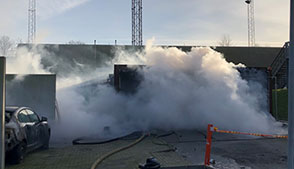Published: 15.12.23
DBI – the Danish Institute of Fire and Security Technology has tested a solution based on early detection and a water mist system for multi-storey and underground car parks. The fire test shows that the solution can prevent the spread of an electric vehicle fire to vehicles parked alongside for at least 30 minutes.
Electric vehicles are taking over Denmark and the rest of Europe. For example, more than half of new vehicle sales in Denmark are now electric or plug-in hybrid vehicles. Consequently, there will also be greater numbers of electric vehicles in multi-storey and underground car parks, and although there is a statistically greater risk of a conventional vehicle catching fire, this trend should be taken into account. Fires in lithium batteries are much more difficult to extinguish.
Siemens and Danfoss Fire Safety are therefore now offering a solution that combines detection with smoke and temperature detectors and water mist fire suppression. A solution that the companies have asked DBI to test to verify that it works as intended.
“The companies approached DBI because they wanted to demonstrate the combination of contemporary detection equipment with high-pressure water mist can detect and contain an electric vehicle fire in a multi-storey or underground car park. They wanted us to design the test assembly, define the success criteria and run the test without their interference,” says Thomas Davidsen, Project Manager and Naval Architect at the Department of Energy & Transport at DBI.
The test assembly was set up at DBI’s test facilities at RESC in the Danish town of Korsør, with shipping containers grouped together to form the framework for the test. The same test installation was used in DBI's ELBAS project (Electric Vehicle Fires at Sea: New Technologies and Methods For Suppression, Containment, and Extinguishing for Battery Car Fires On Board Ships) – but while they acted as a ship’s deck in ELBAS, they simulated a car park in this test.
“There were three parking spaces, with an electric vehicle parked in the middle – a used but intact Renault ZOE – with conventional vehicles placed on either side with 60 cm spacing. Unlike ELBAS, where there were no end walls in the test assembly, so, for example, a crew could practise firefighting from both ends of the parked vehicles, the vehicles in our test assembly were parked against a wall like in a multi-storey. This also prevented the wind from affecting the detection process and water mist,” explains Anders V. Kristensen, project manager at DBI.
Smoke and temperature detectors and water mist systems were installed in the ceiling above the vehicles in accordance with the relevant guidelines, and one of the established success criteria was that, from detection of the battery fire and activation of the water mist system, no fire would spread from the burning electric vehicle to the adjacent vehicles for 30 minutes.
“The time requirement was set on the basis that, among other things, it is a realistic response time for the emergency services to arrive and start extinguishing the fire,” says Anders V. Kristensen, adding that DBI built in a short delay in the spread of the water mist to account for the fact that in a car park, depending on the location in relation to the pump station, pressure would have to be built up in the pipes.
DBI also took more different temperature readings in and around the burning electric vehicle to monitor the heat generated from the fire, which started by a short-circuit in the battery to create a 'thermal runaway'.
“We did the test three times with a new Renault Zoe each time. However, the heat generated was so strong that damage was caused to our test facility, and in two of the three tests, the accumulation of flue gases in the cabin from the battery caused an explosion so powerful that it blew away the rear wall. This was a new, important lesson, also for RESC,” says Thomas Davidsen and continues:
“But in none of the tests did the fire spread to the other vehicles for 30 minutes, which means the project was a success. In fact, the other vehicles in all three tests were completely undamaged despite the relatively fierce fire and explosions. Siemens and Danfoss have received documentation that their system, under the circumstances, serves its purpose,” says Thomas Davidsen.
In connection with the project, Siemens has prepared a white paper entitled 'Fire safety in parking garages with electric vehicles'.
It can be downloaded here.

Anders V. Kristensen
Project Manager
+45 50 80 78 09
avk@dbigroup.dk
